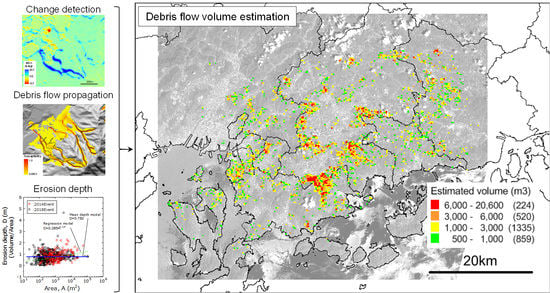Fusion Analysis of Optical Satellite Images and Digital Elevation Model for Quantifying Volume in Debris Flow Disaster
Abstract
:1. Introduction
2. Related Works and Research Objective
3. Methodology and Used Data
4. LiDAR Data Analysis
5. Fusion Analysis of Optical Satellite Images and DEM
5.1. NDVI-based Change Detection
5.2. Debris Flow Propagation Analysis
6. Estimation of Debris Flow Volumes
7. Conclusions
Author Contributions
Funding
Acknowledgments
Conflicts of Interest
References
- Cruden, D.M.; Varnes, D.J. Landslide types and process. Spec. Rep. Trans. Res. Board Nat. Acad. Sci. 1996, 249, 36–75. [Google Scholar]
- U. S. Geological Survey. Landslide Types and Process. 2019. Available online: https://pubs.usgs.gov/fs/2004/3072/pdf/fs2004-3072.pdf (accessed on 20 February 2019).
- Wang, G.; Sassa, K.; Fukuoka, H. Downslope volume enlargement of a debris slide-debris flow in the 1999 Hiroshima, Japan, rainstorm. Eng. Geol. 2003, 69, 309–330. [Google Scholar] [CrossRef]
- Wang, F.; Wu, Y.-H.; Yang, H.; Tanida, Y.; Kamei, A. Preliminary investigation of the 20 August 2014 debris flows triggered by a severe rainstorm in Hiroshima City, Japan. Geoenviron. Disasters 2015, 2, 17. [Google Scholar] [CrossRef]
- Miura, H. Soil Volume estimation in debris flow areas using LiDAR data in the 2014 Hiroshima, Japan rainstorm. In Proceedings of the SPIE 2015, Toulouse, France, 16 March 2015. [Google Scholar] [CrossRef]
- Tsurugi, H.; Seino, N.; Kawase, H.; Imada, Y.; Nakaegawa, T.; Takayabu, I. Meteorological overview and mesoscale characteristics of the heavy rain event of July 2018 in Japan. Landslides 2018, 16, 363–371. [Google Scholar] [CrossRef]
- Hirota, K.; Konagai, K.; Sassa, K.; Dang, K.; Yoshinaga, Y.; Wakita, E.K. Landslides triggered by the west Japan heavy rain of July 2018, and geological and geomorphological features of soaked mountain slopes. Landslides 2019, 16, 189–194. [Google Scholar] [CrossRef]
- Hiroshima Prefecture. Damage Situation by the Heavy Rain of July 2018 in Japan. 2019. (In Japanese). Available online: https://www.pref.hiroshima.lg.jp/uploaded/attachment/323003.pdf (accessed on 20 February 2019).
- Hervás, J.; Barredo, J.I.; Rosin, P.L.; Pasuto, A.; Mantovani, F.; Silvano, S. Monitoring landslides from optical remotely sensed imagery: Case history of Tessina landslide, Italy. Geomorphology 2003, 54, 63–75. [Google Scholar] [CrossRef]
- Miura, H.; Midorikawa, S. Detection of slope failure areas due to the 2004 Niigata-ken Chuetsu earthquake using high-resolution satellite images and digital elevation model. J Japan Assoc. Earthq. Eng. 2007, 7, 1–14. [Google Scholar]
- Tsai, F.; Hwang, J.-H.; Chen, L.-C.; Lin, T.-H. Post-disaster assessment of landslide in southern Taiwan after 2009 Typhoon Morakot using remote sensing and spatial analysis. Nat. Hazard. Earth. Syst. Sci. 2010, 10, 2179–2190. [Google Scholar] [CrossRef]
- Martha, T.R.; Kerle, N.; Jetten, V.; van Westen, C.J.; Kumar, K.V. Characterising spectral, spatial and morphometric properties of landslides for semi-automatic detection using object-oriented methods. Geomorphology 2010, 116, 24–36. [Google Scholar] [CrossRef]
- Rau, J.-Y.; Jhan, J.-P.; Rau, R.-J. Semiautomatic object-oriented landslide recognition scheme from multisensory optical imagery and DEM. IEEE Trans. Geosci. Remote Sens. 2014, 52, 1336–1349. [Google Scholar] [CrossRef]
- Hölbling, D.; Friedl, B.; Eisank, C. An object-based approach for semi-automated landslide change detection and attribution of changes to landslide classes in northern Taiwan. Earth. Sci. Inform. 2015, 8, 327–335. [Google Scholar] [CrossRef] [Green Version]
- Fiorucci, F.; Ardizzone, F.; Mondini, A.C.; Viero, A.; Guzzetti, F. Visual interpretation of stereoscopic NDVI satellite images to map rainfall-induced landslides. Landslides 2019, 16, 165–174. [Google Scholar] [CrossRef]
- Ghorbanzadeh, O.; Blaschke, T.; Gholamnia, K.; Meena, S.R.; Tiede, D.; Aryal, J. Evaluation of different machine learning methods and deep-learning convolutional neural networks for landslide detection. Remote Sens. 2019, 11, 196. [Google Scholar] [CrossRef]
- Lu, P.; Stumpf, A.; Kerle, N.; Casagli, N. Object-oriented change detection for landslide rapid mapping. IEEE Geosci. Remote. Sens. Lett. 2011, 8, 701–705. [Google Scholar] [CrossRef]
- Lv, Z.-Y.; Shi, W.; Zhang, X.; Benedikt, J.A. Landslide inventory mapping from bitemporal high-resolution remote sensing images using change detection and multiscale segmentation. IEEE J. Sel. Top. Appl. Earth Obs. Remote Sens. 2018, 11, 1520–1532. [Google Scholar] [CrossRef]
- Chiang, S.-H.; Chang, K.-T.; Mondini, A.C.; Tsai, B.-W.; Chen, C.-Y. Simulation of event-based landslides and debris flow at watershed level. Geomorphology 2012, 138, 306–318. [Google Scholar] [CrossRef]
- Horton, P.; Jaboyediff, M.; Rudaz, B.; Zimmermann, M. Flow-R, a model for susceptibility mapping of debris flows and other gravitational hazards at a regional scale. Nat. Hazard. Earth Syst. Sci. 2013, 13, 869–885. [Google Scholar] [CrossRef] [Green Version]
- Schilling, S.P. Laharz-py: GIS Tools for Automated Mapping of Lahar Inundation Hazard Zones; U.S. Geological Survey Open-File Report: Reston, VA, USA, 2014; No.2014-1073.
- Melo, R.; Van Asch, T.; Zezere, J.L. Debris flow run-out simulation and analysis using a dynamic model. Nat. Hazar. Earth Syst. Sci. 2018, 18, 555–570. [Google Scholar] [CrossRef]
- Scheidl, C.; Rickenmann, D.; Chiari, M. The use of airborne LiDAR data for the analysis of debris flow events in Switzerland. Nat. Hazard. Eart. Syst. Sci. 2008, 8, 1113–1127. [Google Scholar] [CrossRef] [Green Version]
- Jaboyedoff, M.; Oppikofer, T.; Abellán, A.; Derron, M.-H.; Loye, A.; Metzger, R.; Pedrazzini, A. Use of LIDAR in landslide investigations: A review. Nat. Hazard. 2012, 61, 5–28. [Google Scholar] [CrossRef]
- Bremer, M.; Sass, O. Combining airborne and terrestrial laser scanning for quantifying erosion and deposition by a debris flow event. Geomorphology 2012, 138, 49–60. [Google Scholar] [CrossRef]
- Tseng, C.-M.; Lin, C.-W.; Stark, C.P.; Liu, J.-K.; Fei, L.-Y.; Hsieh, Y.-C. Application of a multi-temporal, LiDAR-derived, digital terrain model in a landslide-volume estimation. Earth. Surf. Process. Landf. 2013, 38, 1587–1601. [Google Scholar] [CrossRef]
- Tsutsui, K.; Rokugawa, S.; Nakagawa, H.; Miyazaki, S.; Cheng, C.-T.; Shiraishi, T.; Yang, S.-D. Detection and volume estimation of large-scale landslides based on elevation-change analysis using DEMs extracted from high-resolution satellite stereo imagery. IEEE Trans. Geosci. Remote Sens. 2007, 45, 1681–1696. [Google Scholar] [CrossRef]
- Martha, T.R.; Kerle, N.; Jetten, V.; van Westen, J.C.; Kumar, K.V. Landslide volumetric analysis using Cartosat-1-derived DEMS. IEEE Geosci. Remote Sens. Lett. 2010, 7, 582–586. [Google Scholar] [CrossRef]
- Innes, J.N. Lichenometric dating of debris-flow deposits in the Scottish Highlands. Earth. Surf. Process. Landf. 1983, 8, 579–588. [Google Scholar] [CrossRef]
- Laesen, M.C.; Torres-Sahchez, A.J. The frequency and distribution of recent landslides in three montane tropical regions of Puerto Rico. Geomorphology 1998, 24, 309–331. [Google Scholar] [Green Version]
- Guthrie, R.H.; Evans, S.G. Analysis of landslide frequencies and characteristics in a natural system, coastal British Columbia. Earth. Surf. Process. Landf. 2004, 29, 1321–1339. [Google Scholar] [CrossRef]
- Imaizumi, F.; Sidle, R.C. Linkage of sediment supply and transport processes in Miyagawa Dam catchment, Japan. J. Geophys. Res. 2007, 112, 3012. [Google Scholar] [CrossRef]
- Imaizumi, F.; Sidle, R.C.; Kamei, R. Effects of forest harvesting on the occurrence of landslides and debris flows in steep terrain of central Japan. Earth. Surf. Process. Landf. 2008, 33, 827–840. [Google Scholar] [CrossRef]
- Guzzetti, F.; Ardizzone, F.; Cardinali, M.; Rossi, M.; Valigi, D. Landslide volumes and landslide mobilization rates in Umbria, central Italy. Earth. Planet. Sci. Lett. 2009, 279, 222–229. [Google Scholar] [CrossRef]
- The Association of Japanese Geographers. 2019. (In Japanese). Available online: http://ajg-disaster.blogspot.com/2018/07/3077.html (accessed on 22 February 2019).
- Copernicus Open Access Hub. 2019. Available online: https://scihub.copernicus.eu/ (accessed on 25 February 2019).
- Geospatial Information Authority of Japan. 2019; (In Japanese). Available online: https://fgd.gsi.go.jp/download/menu.php (accessed on 25 February 2019).
- Hodgson, M.E.; Bresnahan, P. Accuracy of airborne Lidar-derived elevation: Empirical assessment and error budget. Photogramm. Eng. Remote Sens. 2004, 70, 331–339. [Google Scholar] [CrossRef]
- Aguilar, F.J.; Mills, J.P.; Delgado, J.; Aguilar, M.A.; Negreiros, J.G.; Pérez, J.L. Modelling vertical error in LiDAR-derived digital elevation models. ISPRS J. Photogramm. Remote Sens. 2010, 65, 103–110. [Google Scholar] [CrossRef]
- Main-Knorn, M.; Pflug, B.; Louis, J.; Debaecker, V.; Müller-Wilm, U.; Gascon, F. Sen2Cor for Sentinel-2. In Proceedings of the SPIE 2017, 10427, Image and Signal Processing for Remote Sensing XXIII, Bellingham, DC, USA, 11–13 September 2018. [Google Scholar] [CrossRef]
- Miura, H.; Midorikawa, S.; Kerle, M. Detection of building damage areas of the 2006 Central Java, Indonesia, earthquake through digital analysis of optical satellite images. Earthq. Spectr. 2013, 29, 453–473. [Google Scholar] [CrossRef]
- Holmgren, P. Multiple flow direction algorithms for runoff modelling in grid based elevation models: An empirical evaluation. Hydrol. Process. 1994, 8, 327–334. [Google Scholar] [CrossRef]
- Miura, H.; Hiasa, K. Applicability of empirical models to urban areas for predicting debris flow inundation areas by using digital elevation model. J. Inst. Soc. Saf. Sci. 2017, 31, 309–318. [Google Scholar]
- Gamma, P. dfwalk—Ein Murgang-Simulationsprogramm zur Gefahrenzonierung; Geographisches Institut der Universitat Bern: Bern, Switzerland, 2000. [Google Scholar]
- Ministry of Land, Infrastructure, Transport and Tourism. Damage Report of the Landslide Disaster Due to the Heavy Rain of July 2018. (In Japanese). Available online: http://www.mlit.go.jp/river/sabo/committee_jikkousei/180911/02shiryo2.pdf (accessed on 29 March 2019).
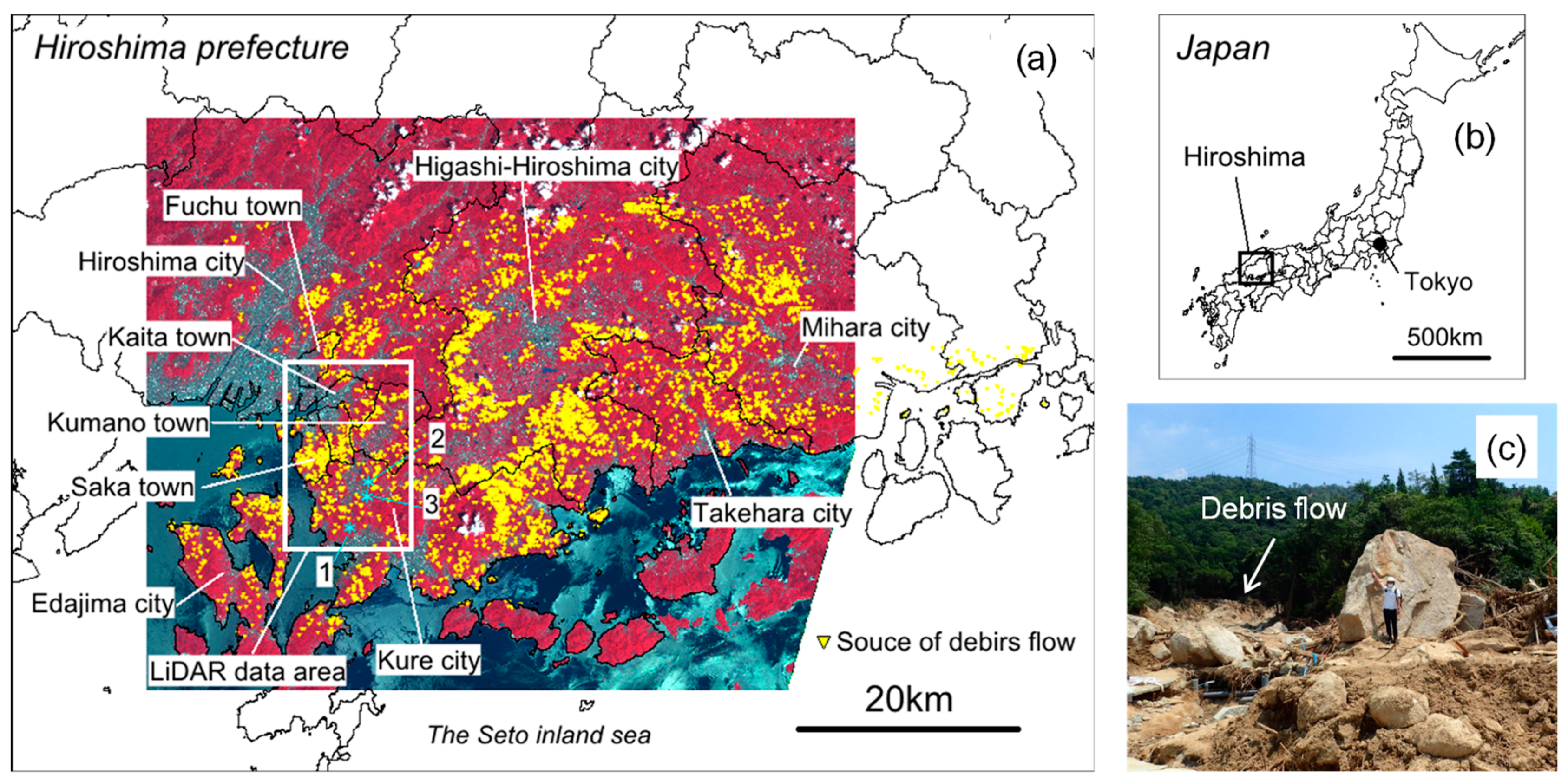
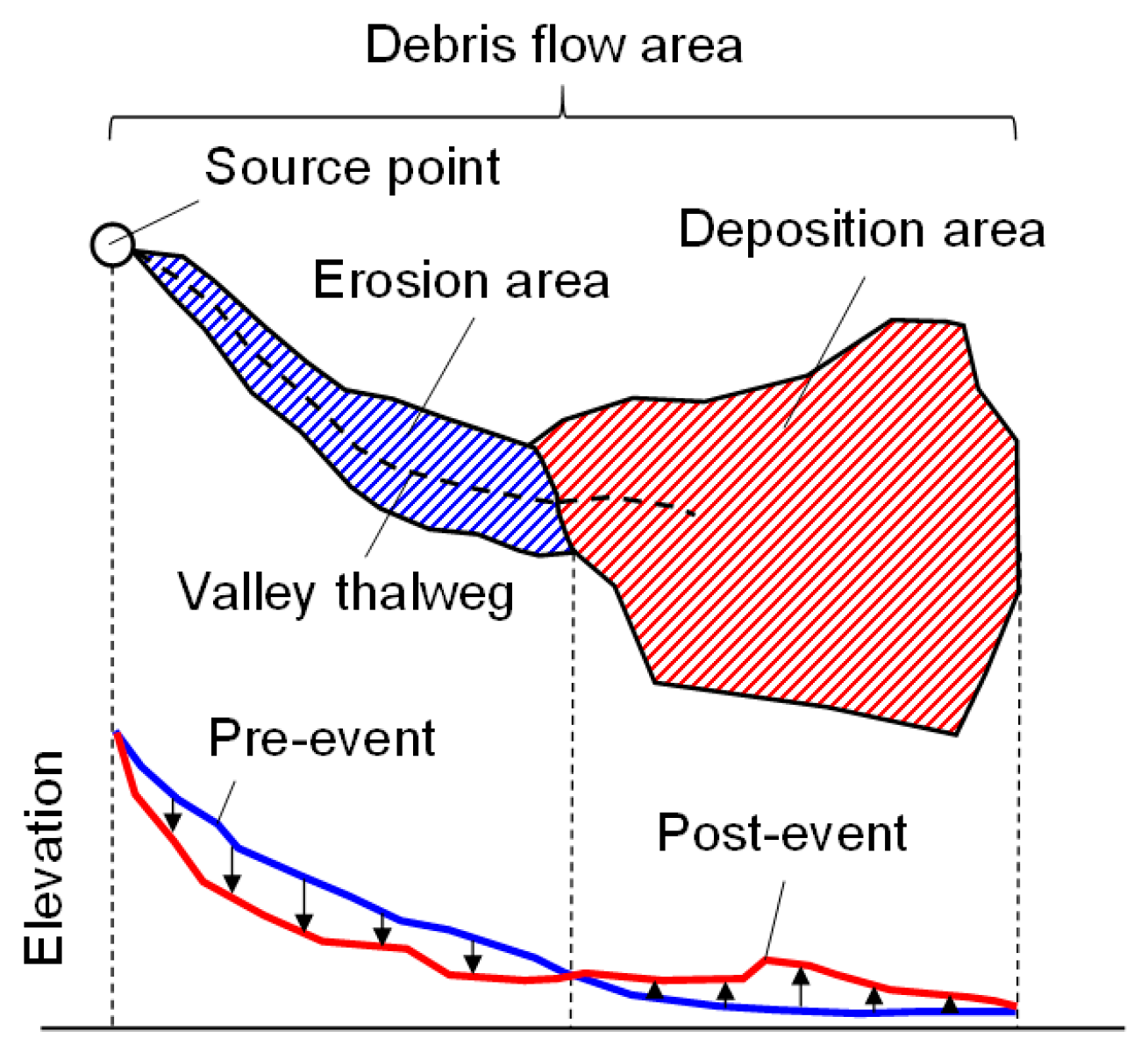
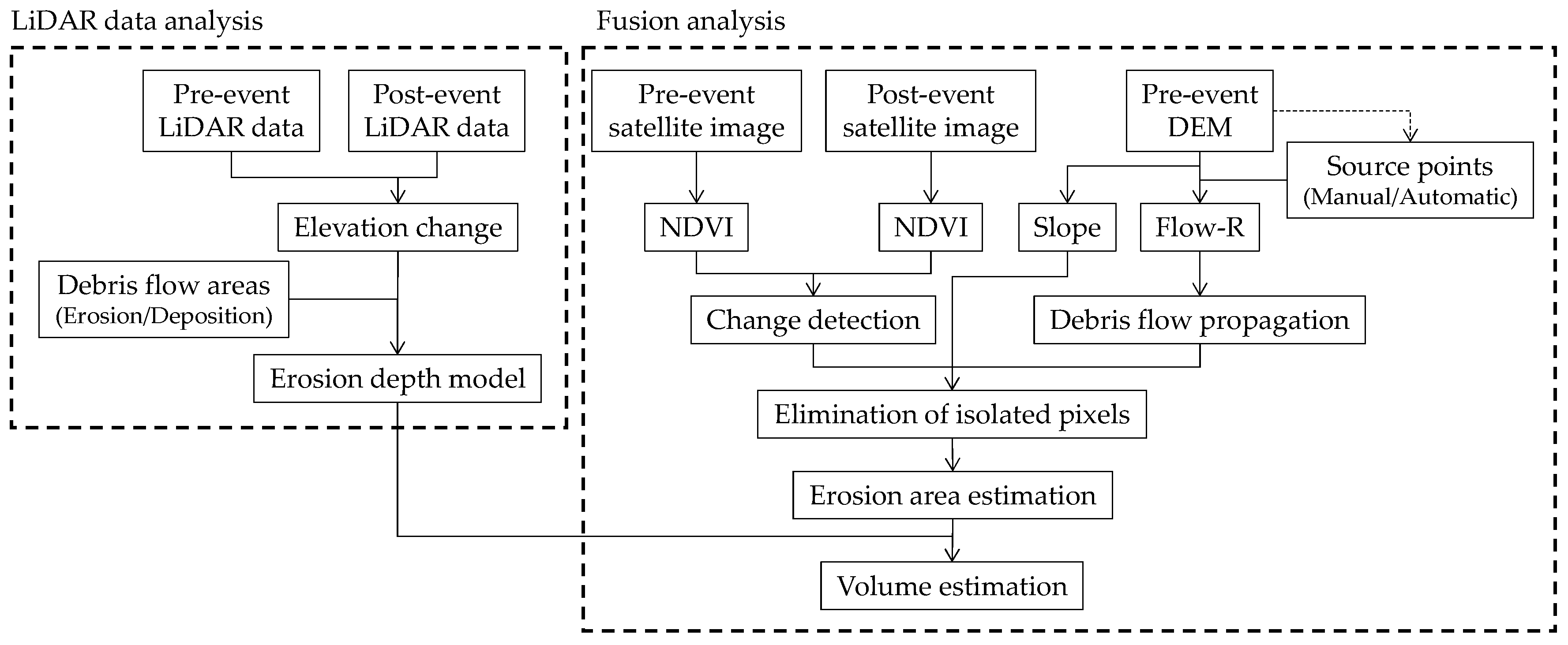
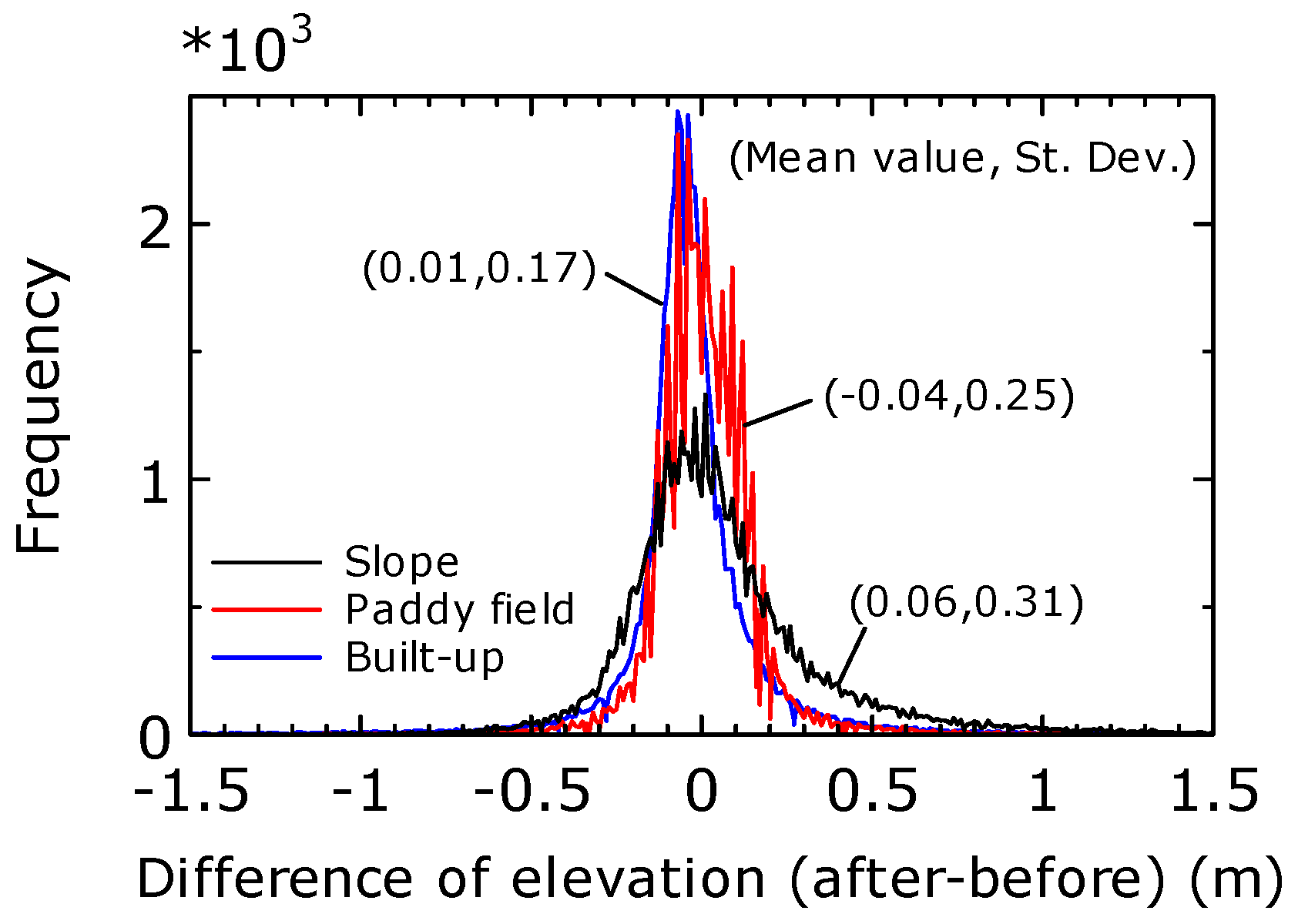
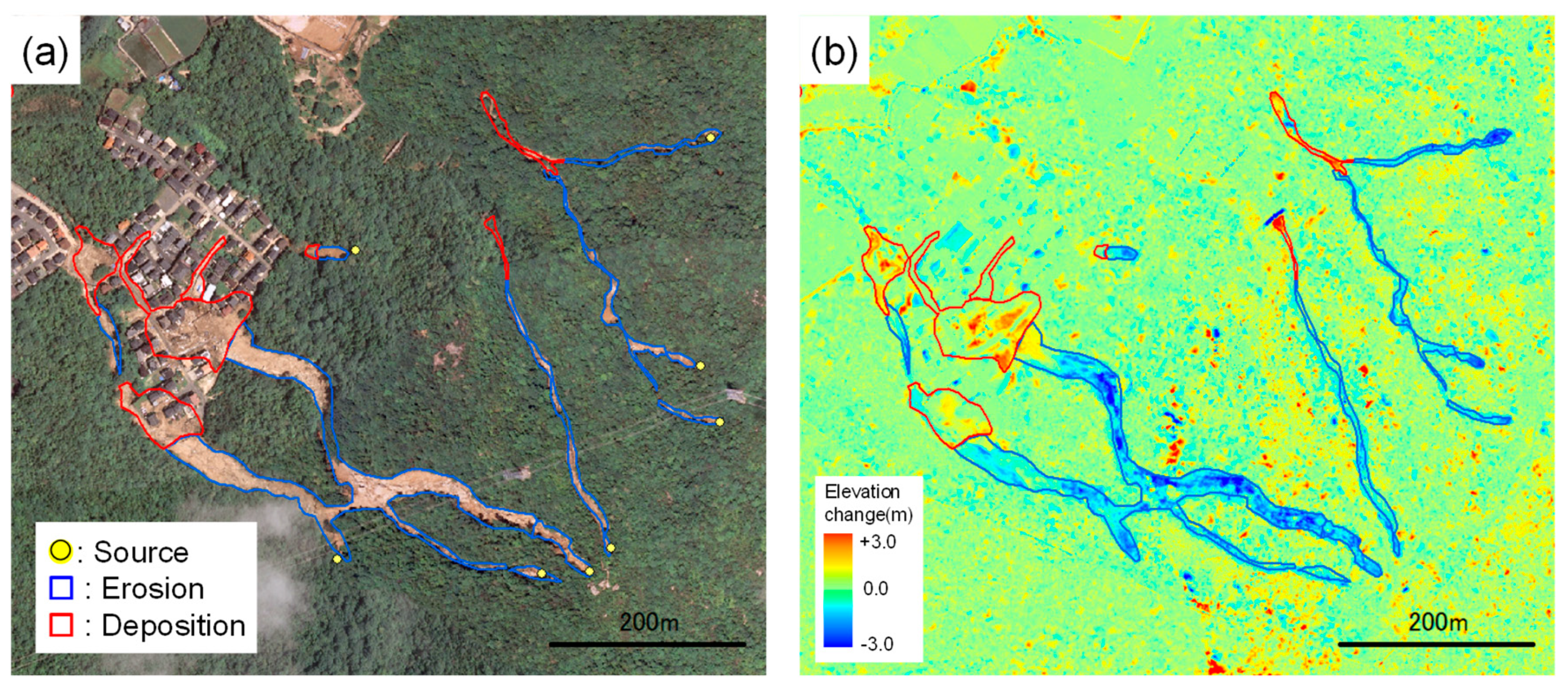
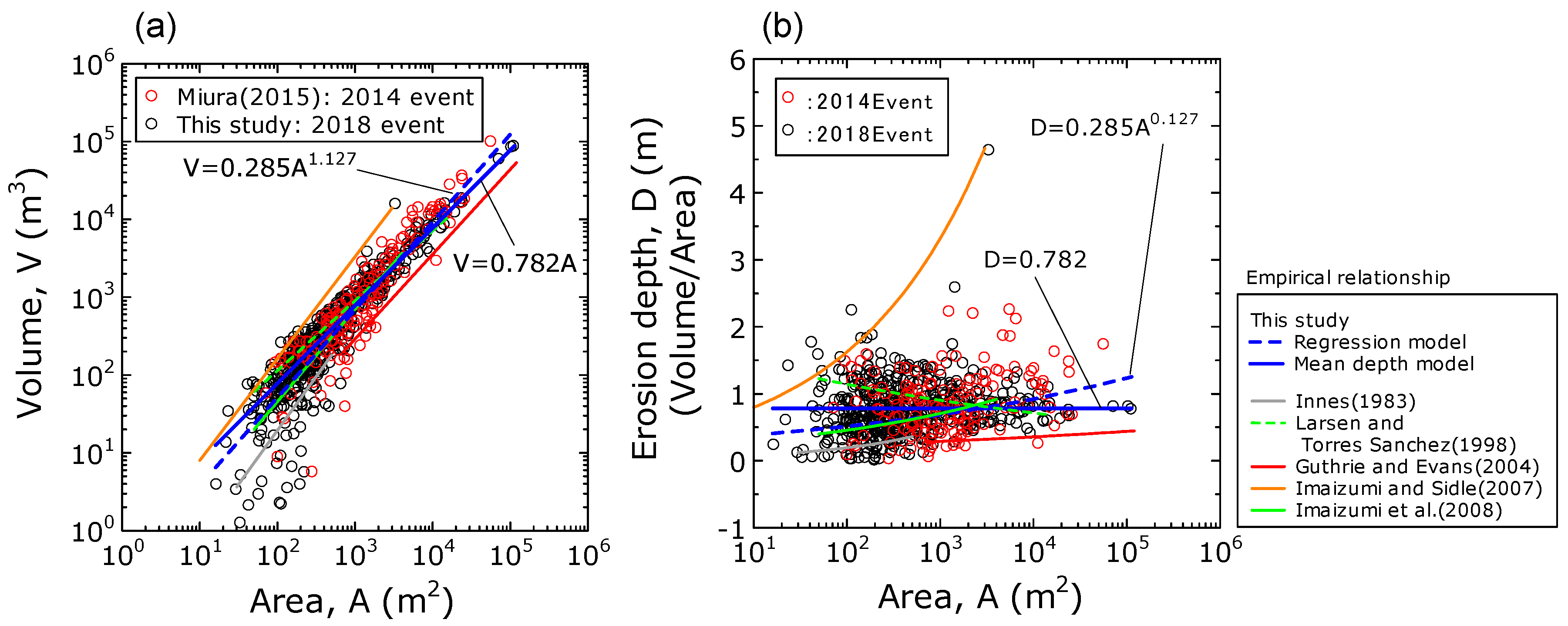
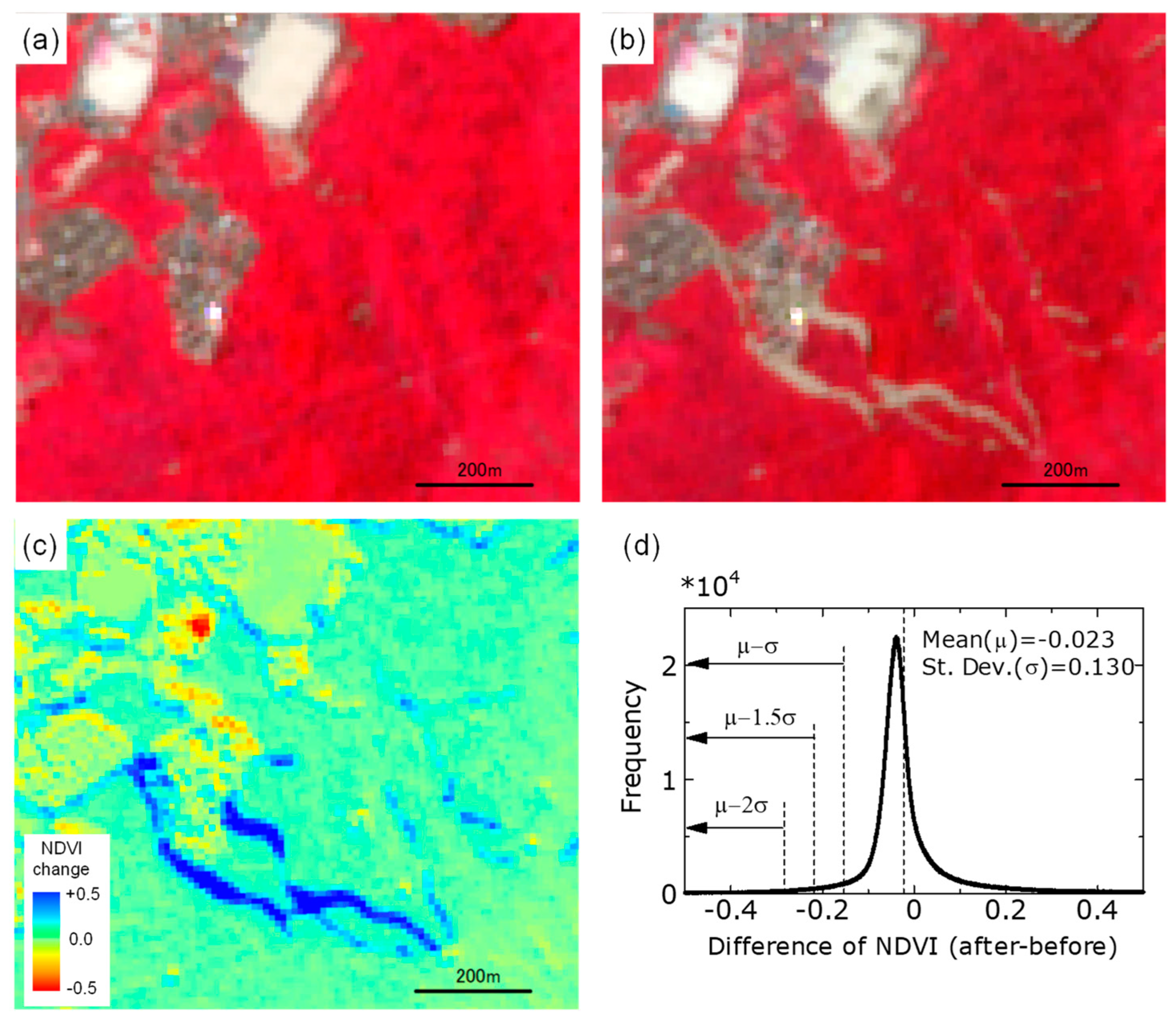
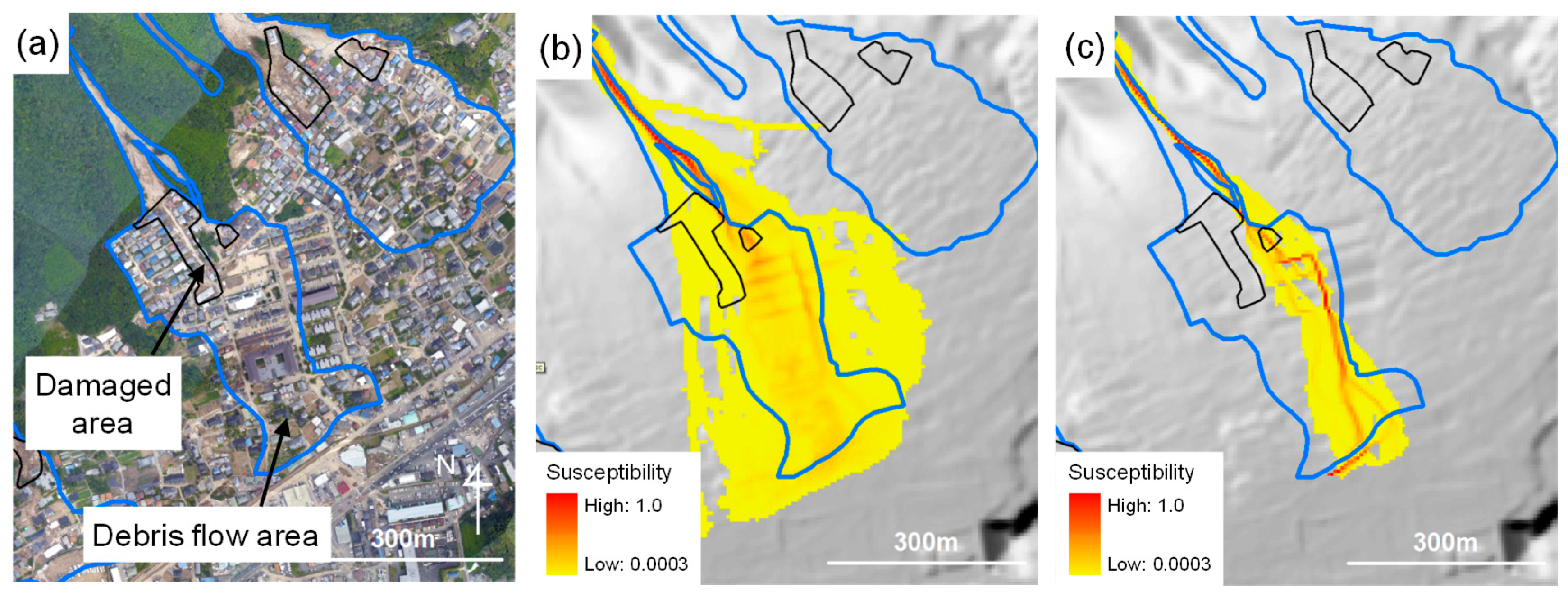
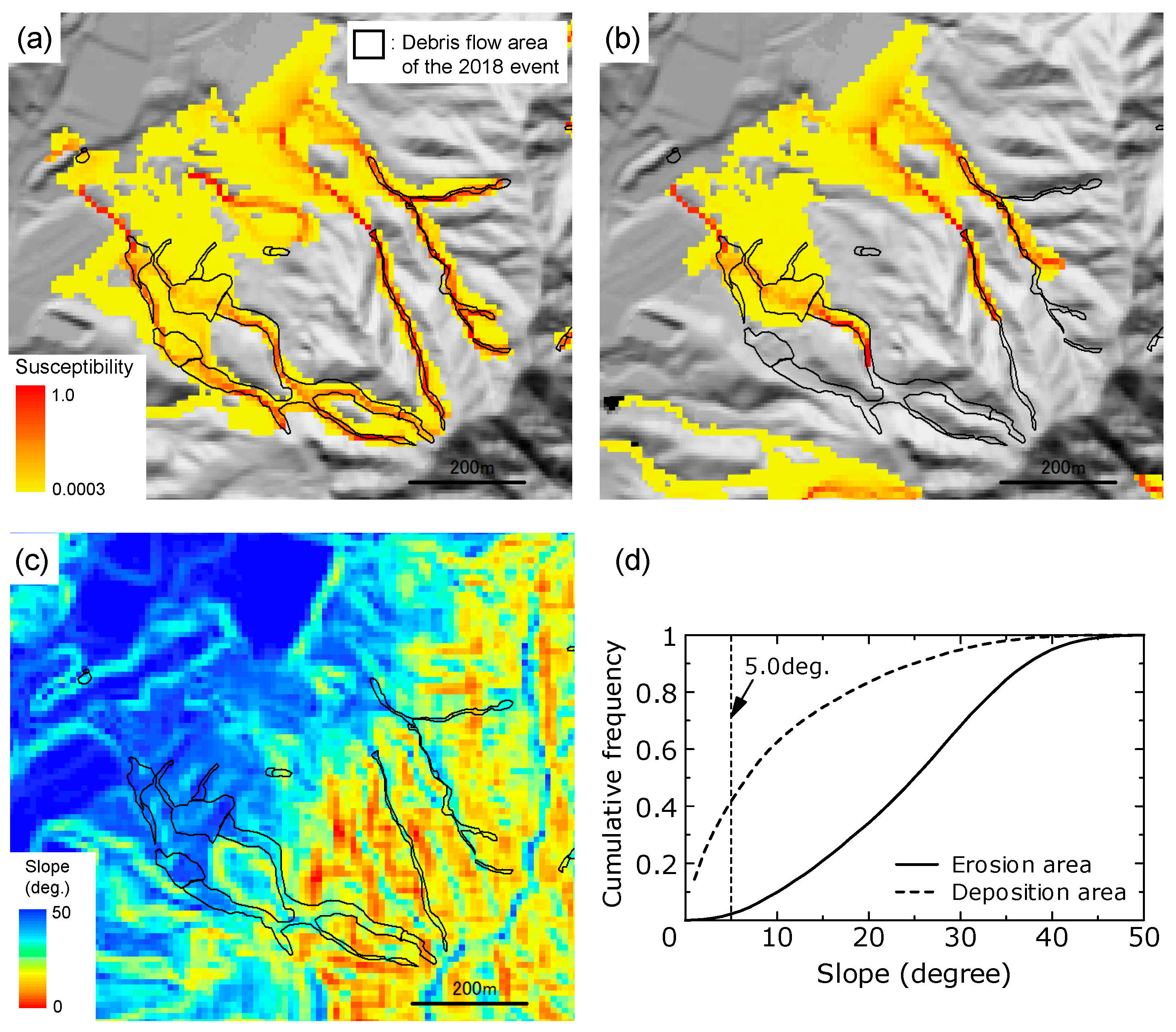
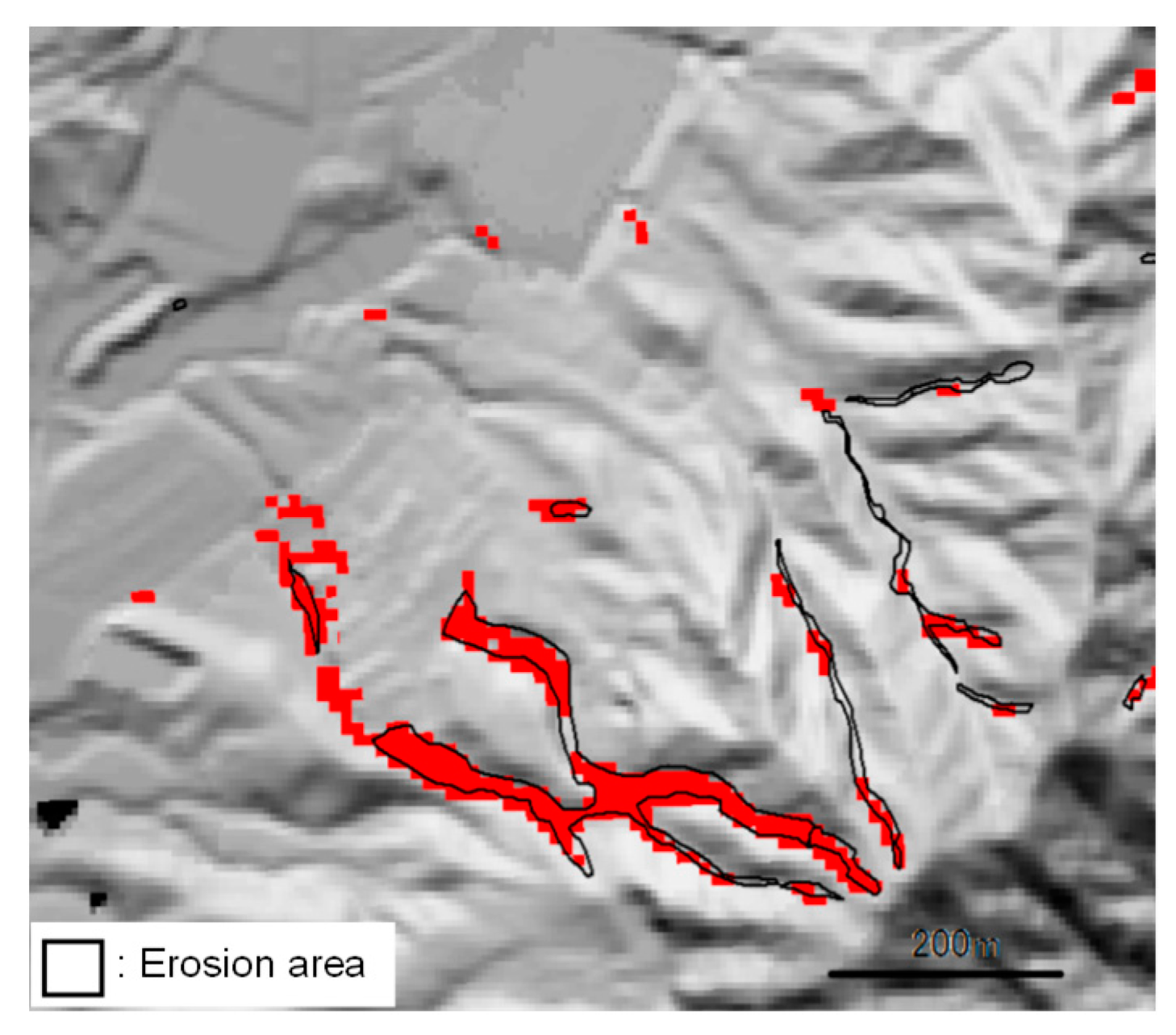
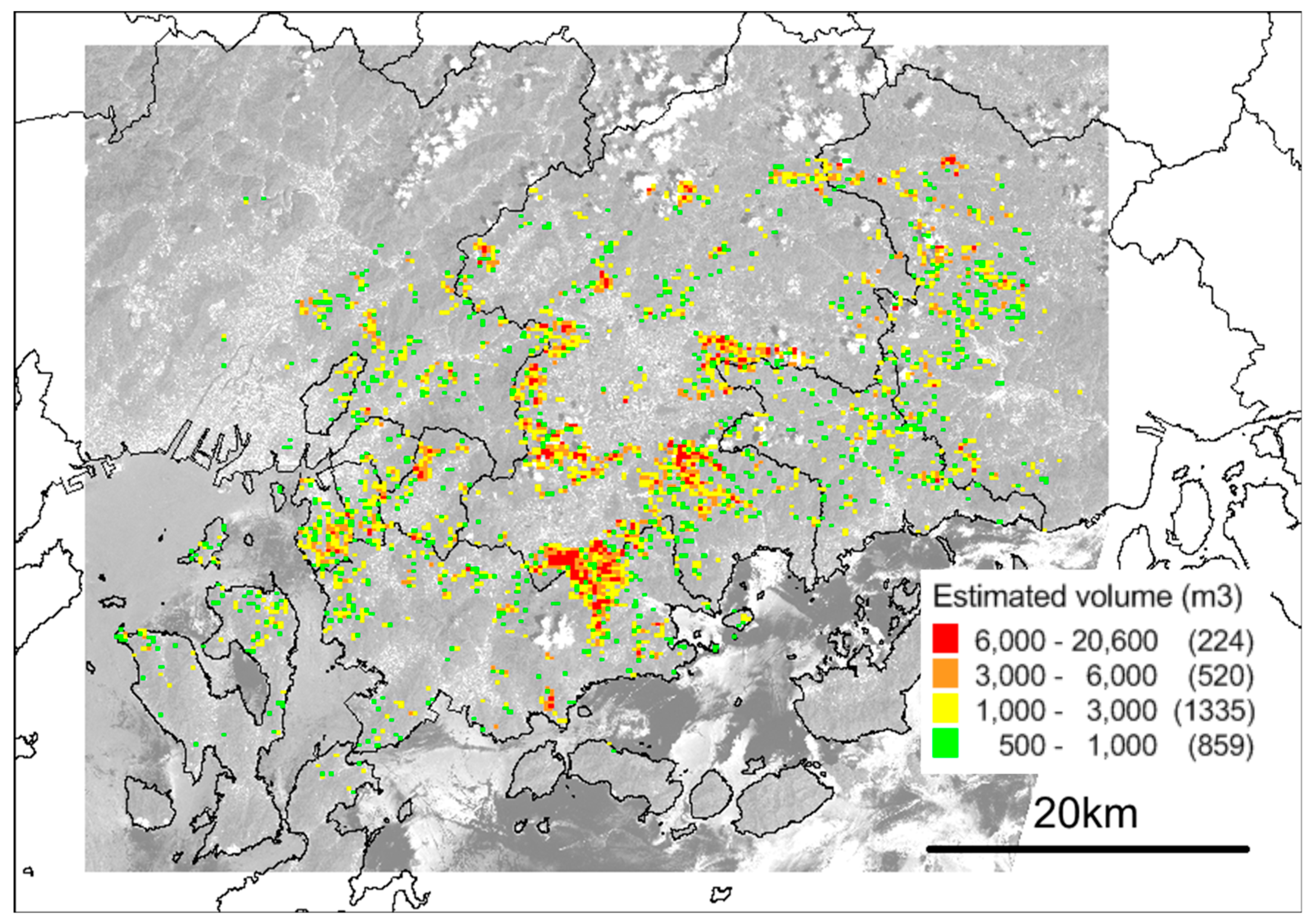

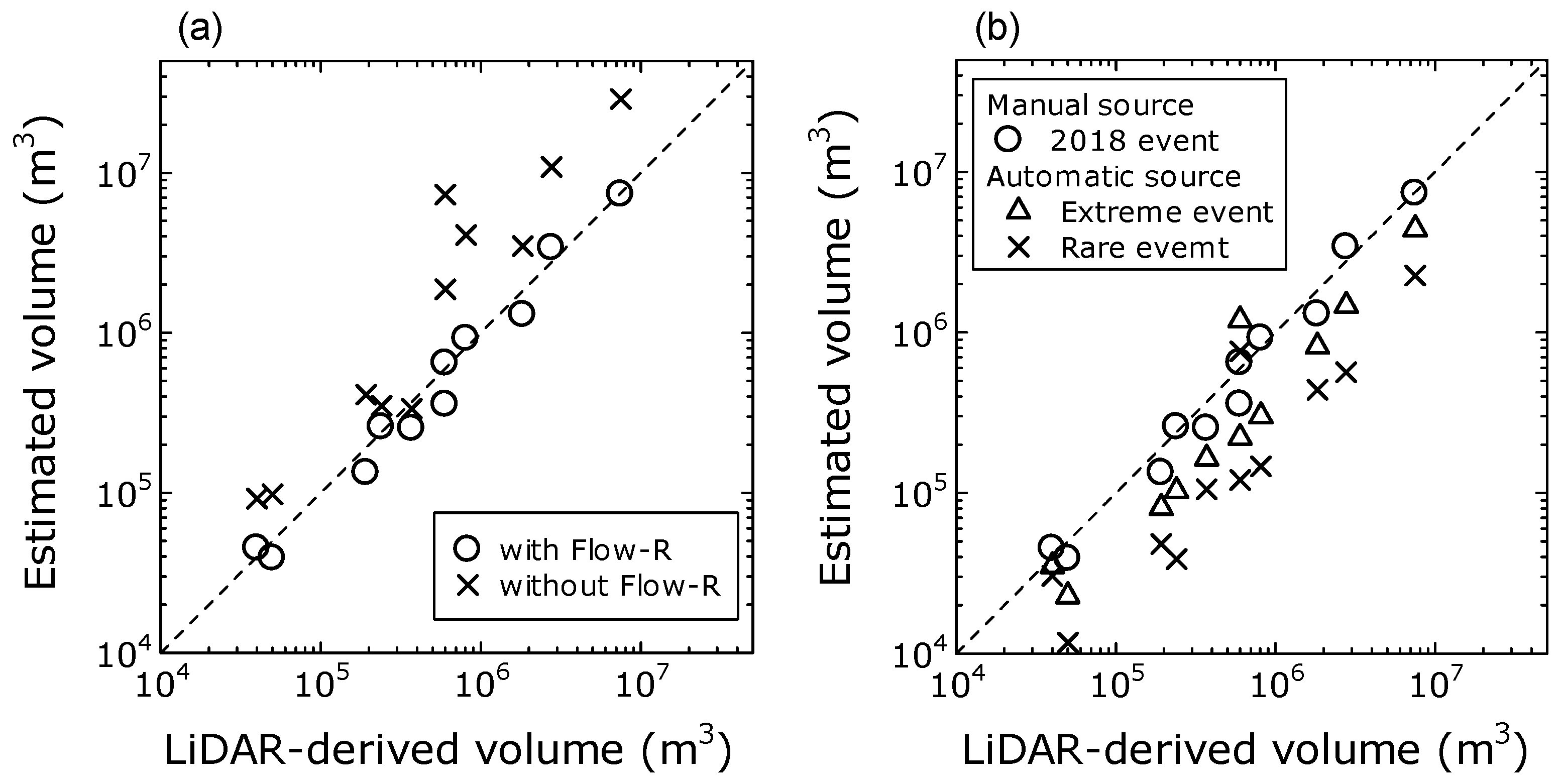
| Data | Timing | Acquisition Date | Spatial Resolution (m) |
|---|---|---|---|
| LiDAR-derived DEM *1 | Pre-event | 2015–2017 | 1 |
| Post-event | 15–24 July 2018 | 1 | |
| Optical satellite image (Sentinel-2 *2) | Pre-event | 1 June 2018 | 10 |
| Post-event | 16 July 2018 | 10 | |
| DEM derived by LiDAR and photogrammetry *3 | Pre-event | 2015 | 10(5) |
| ID | Equation | Minimum A (m2) | Maximum A (m2) | N | Source |
|---|---|---|---|---|---|
| 1 | V = 0.285A1.127 | 1.6 × 101 | 1.1 × 105 | 637 | Regression model (This study) |
| 2 | V = 0.782A | Mean depth model (This study) | |||
| 3 | V = 0.0329A1.3852 | 3 × 101 | 5 × 102 | 30 | Innes (1983) |
| 4 | V = 1.826A0.898 | 5 × 101 | 1.6 × 104 | 1019 | Larsen and Torres-Sanchez (1998) |
| 5 | V = 0.1549A1.0905 | 7 × 102 | 1.2 × 105 | 124 | Guthrie and Evans (2004) |
| 6 | V = 0.39A1.31 | 1 × 101 | 3 × 103 | 51 | Imaizumi and Sidle (2007) |
| 7 | V = 0.19A1.19 | 5 × 101 | 4 × 103 | 11 | Imaizumi et al. (2008) |
| Spreading Algorithm | Direction Algorithm | Holmgren (1994) Modified | x | 4 |
| dh (m) | 2 | |||
| Persistence | Weights, w | Default (Uniform weights 1.0 for all directions) | ||
| Energy calculation | Friction loss function | Threshold of travel angle(deg.) | 7 | |
| Energy limitation | Maximum velocity(m/s) | 15 | ||
| w0 | w45 | w90 | w135 | w180 | |
|---|---|---|---|---|---|
| Default | 1 | 1 | 1 | 1 | 1 |
| Gamma [2000] | 1.5 | 1 | 1 | 1 | 0 |
| ID | Municipality | Volume (Million Cubic Meters, ×106 m3) | |||||
|---|---|---|---|---|---|---|---|
| Observed | Estimated | ||||||
| LiDAR * | Manual Source | Without Flow-R | Automatic Source | ||||
| Name | Area (sq km) | with Flow-R | Extreme Event | Rare Event | |||
| 1 | Hiroshima city | 902 | 0.60 | 0.65 | 7.32 | 1.19 | 0.76 |
| 2 | Kure city | 352 | 1.83 | 1.30 | 3.48 | 0.82 | 0.44 |
| 3 | Higashi-Hiroshima city | 636 | 2.77 | 3.40 | 10.89 | 1.47 | 0.57 |
| 4 | Takehara city | 118 | 0.60 | 0.36 | 1.87 | 0.22 | 0.12 |
| 5 | Mihara city | 471 | 0.81 | 0.92 | 4.08 | 0.30 | 0.15 |
| 6 | Edajima city | 100 | 0.19 | 0.13 | 0.41 | 0.08 | 0.05 |
| 7 | Kumano town | 34 | 0.24 | 0.26 | 0.35 | 0.10 | 0.04 |
| 8 | Saka town | 16 | 0.37 | 0.25 | 0.34 | 0.16 | 0.11 |
| 9 | Fuchu town | 10 | 0.05 | 0.04 | 0.10 | 0.02 | 0.01 |
| 10 | Kaita town | 14 | 0.04 | 0.05 | 0.09 | 0.04 | 0.03 |
| Total | 2653 | 7.50 | 7.35 | 28.93 | 4.40 | 2.28 | |
© 2019 by the author. Licensee MDPI, Basel, Switzerland. This article is an open access article distributed under the terms and conditions of the Creative Commons Attribution (CC BY) license (http://creativecommons.org/licenses/by/4.0/).
Share and Cite
Miura, H. Fusion Analysis of Optical Satellite Images and Digital Elevation Model for Quantifying Volume in Debris Flow Disaster. Remote Sens. 2019, 11, 1096. https://doi.org/10.3390/rs11091096
Miura H. Fusion Analysis of Optical Satellite Images and Digital Elevation Model for Quantifying Volume in Debris Flow Disaster. Remote Sensing. 2019; 11(9):1096. https://doi.org/10.3390/rs11091096
Chicago/Turabian StyleMiura, Hiroyuki. 2019. "Fusion Analysis of Optical Satellite Images and Digital Elevation Model for Quantifying Volume in Debris Flow Disaster" Remote Sensing 11, no. 9: 1096. https://doi.org/10.3390/rs11091096
APA StyleMiura, H. (2019). Fusion Analysis of Optical Satellite Images and Digital Elevation Model for Quantifying Volume in Debris Flow Disaster. Remote Sensing, 11(9), 1096. https://doi.org/10.3390/rs11091096




